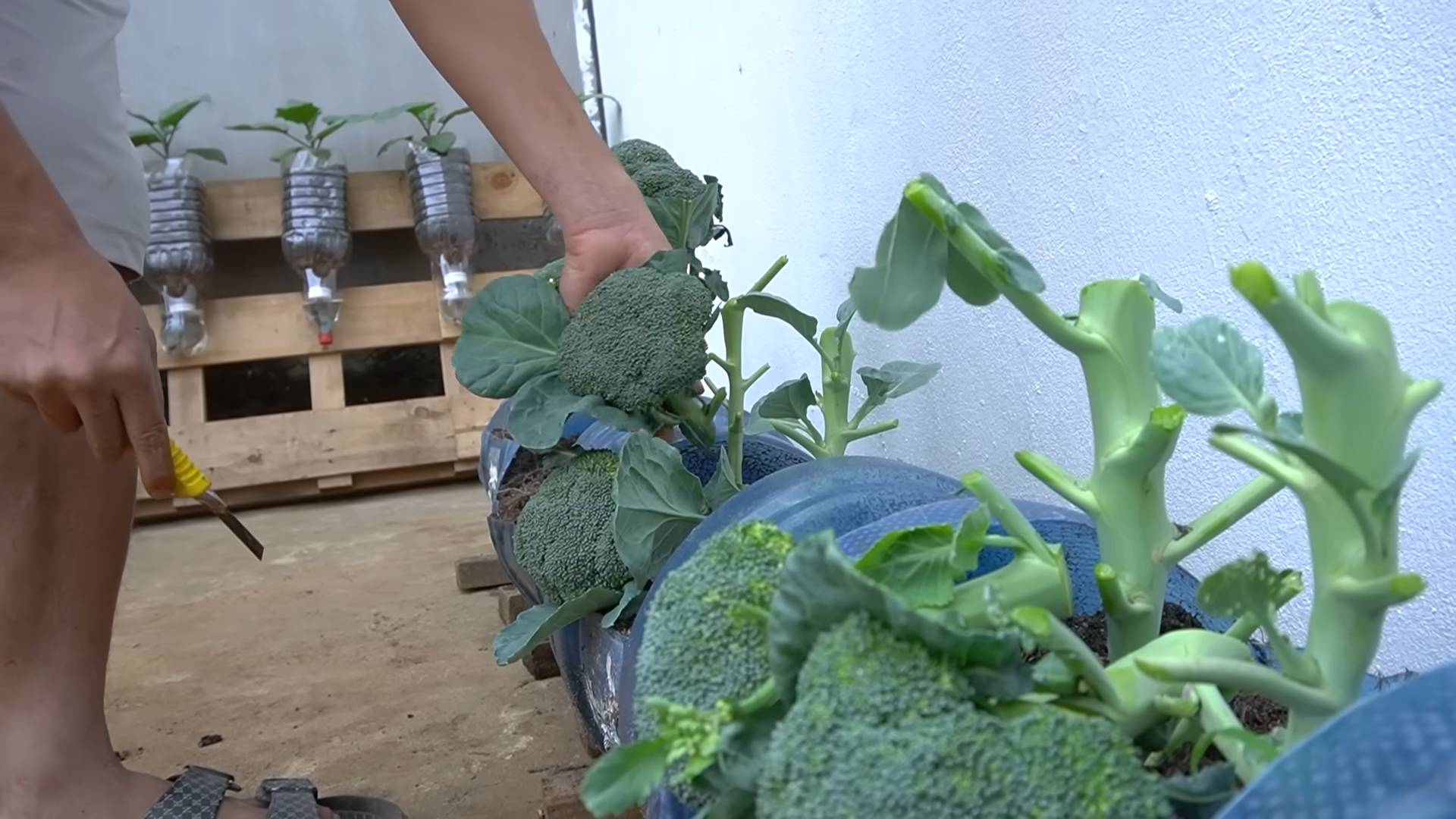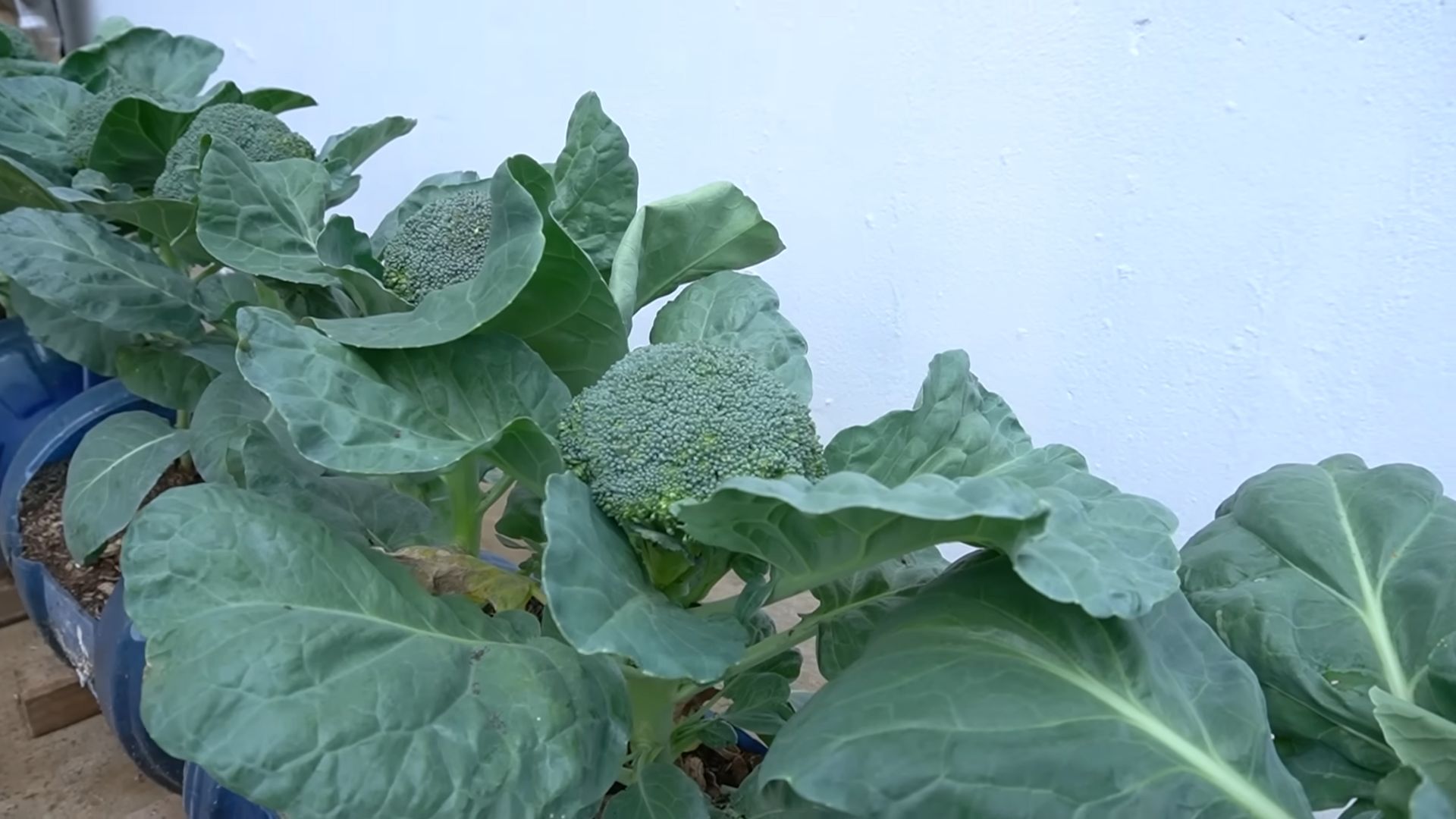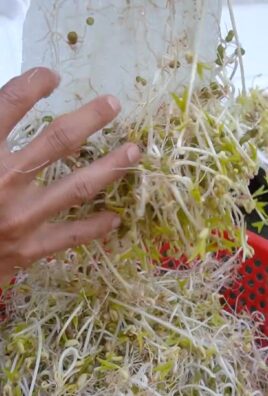Grow Broccoli at Home Easily and unlock the joy of fresh, homegrown goodness right in your backyard! Imagine stepping outside and harvesting crisp, vibrant broccoli florets, knowing exactly where they came from and what went into growing them. Forget those wilted, overpriced heads at the grocery store – with a few simple tricks and a little DIY spirit, you can cultivate your own thriving broccoli patch.
Broccoli, a member of the brassica family, has a rich history dating back to ancient Rome, where it was prized for its nutritional value and unique flavor. Over centuries, it has spread across the globe, becoming a staple in countless cuisines. But beyond its culinary appeal, growing your own broccoli connects you to this long tradition, allowing you to participate in a timeless practice of nurturing the earth and reaping its rewards.
Why should you embark on this DIY adventure? Well, for starters, homegrown broccoli tastes infinitely better! Plus, you have complete control over the growing process, ensuring your broccoli is free from harmful pesticides and chemicals. In this article, I’ll share my favorite home gardening tricks and DIY hacks to help you grow broccoli at home easily, even if you have limited space or experience. Get ready to transform your garden into a broccoli paradise!

Growing Broccoli at Home: A Beginner’s Guide
Hey there, fellow gardening enthusiasts! I’m so excited to share my experience with growing broccoli at home. It’s surprisingly easier than you might think, and nothing beats the taste of fresh, homegrown broccoli. This guide will walk you through every step, from choosing the right variety to harvesting your delicious crop. Let’s get started!
Choosing Your Broccoli Variety
First things first, you need to decide which type of broccoli you want to grow. There are several options, each with its own characteristics and growing requirements. Here are a few popular choices:
- Calabrese: This is the most common type, producing a large central head. It’s a reliable choice for beginners.
- Sprouting Broccoli: Instead of one large head, this variety produces numerous smaller side shoots. It has a longer harvest period.
- Romanesco Broccoli: Known for its unique fractal pattern, Romanesco is a visually stunning and delicious option. It can be a bit more challenging to grow.
- Broccolini: A hybrid of broccoli and Chinese kale, Broccolini has a milder flavor and tender stalks.
I personally love growing Calabrese because it’s relatively easy and produces a good-sized head. But feel free to experiment and find the variety that suits your taste and climate best!
Starting Your Broccoli Seeds
You have two options here: starting your seeds indoors or directly sowing them in your garden. I prefer starting indoors because it gives the seedlings a head start and protects them from pests and harsh weather.
Starting Seeds Indoors
1. Gather Your Supplies: You’ll need seed starting trays or small pots, seed starting mix (not regular potting soil!), broccoli seeds, a spray bottle, and a grow light (optional, but highly recommended).
2. Fill the Trays: Moisten the seed starting mix and fill your trays or pots, leaving about half an inch of space at the top.
3. Sow the Seeds: Plant 2-3 seeds per cell or pot, about ¼ inch deep. Gently cover the seeds with more seed starting mix.
4. Water Carefully: Use a spray bottle to gently water the soil. You want it to be moist but not soggy.
5. Provide Light and Warmth: Place the trays in a warm location (around 70-75°F) and under a grow light if you have one. If not, a sunny windowsill will do, but be sure to rotate the trays regularly to prevent the seedlings from leaning towards the light.
6. Keep the Soil Moist: Check the soil daily and water as needed to keep it consistently moist.
7. Thin the Seedlings: Once the seedlings have their first true leaves (the second set of leaves), thin them to one seedling per cell or pot. Choose the strongest-looking seedling and gently snip off the others at the soil line.
Direct Sowing
If you live in a mild climate with a long growing season, you can directly sow your broccoli seeds in the garden.
1. Prepare the Soil: Choose a sunny spot with well-drained soil. Amend the soil with compost or other organic matter to improve its fertility.
2. Sow the Seeds: Plant the seeds about ½ inch deep and 18-24 inches apart.
3. Water Regularly: Keep the soil consistently moist until the seedlings emerge.
4. Thin the Seedlings: Once the seedlings are a few inches tall, thin them to one plant every 18-24 inches.
Transplanting Your Broccoli Seedlings
Whether you started your seeds indoors or bought seedlings from a nursery, you’ll need to transplant them into your garden.
1. Harden Off the Seedlings: If you started your seeds indoors, you’ll need to harden them off before transplanting. This means gradually exposing them to outdoor conditions over a period of 7-10 days. Start by placing them outside for an hour or two each day, gradually increasing the amount of time they spend outdoors.
2. Prepare the Garden Bed: Choose a sunny location with well-drained soil. Broccoli needs at least 6 hours of sunlight per day. Amend the soil with compost or other organic matter to improve its fertility.
3. Dig the Holes: Dig holes that are slightly larger than the root balls of your seedlings, spacing them 18-24 inches apart.
4. Transplant the Seedlings: Gently remove the seedlings from their trays or pots and place them in the holes. Make sure the top of the root ball is level with the surrounding soil.
5. Fill the Holes: Fill the holes with soil and gently pat it down around the seedlings.
6. Water Thoroughly: Water the seedlings thoroughly after transplanting.
Caring for Your Broccoli Plants
Once your broccoli plants are in the ground, it’s important to provide them with the care they need to thrive.
1. Watering: Broccoli needs consistent moisture, especially during hot weather. Water deeply whenever the top inch of soil feels dry. Avoid overhead watering, as this can lead to fungal diseases. Drip irrigation or soaker hoses are ideal.
2. Fertilizing: Broccoli is a heavy feeder, so it needs regular fertilization. Apply a balanced fertilizer (like 10-10-10) every 2-3 weeks. You can also side-dress with compost or other organic matter.
3. Weeding: Keep the garden bed free of weeds, as they can compete with your broccoli plants for nutrients and water. Hand-pull weeds or use a hoe to remove them.
4. Mulching: Apply a layer of mulch around your broccoli plants to help retain moisture, suppress weeds, and regulate soil temperature. Straw, wood chips, or shredded leaves are all good options.
5. Pest Control: Broccoli is susceptible to several pests, including cabbage worms, aphids, and flea beetles. Inspect your plants regularly and take action if you see any signs of infestation.
* Cabbage Worms: These green caterpillars can quickly devour your broccoli leaves. Hand-pick them off the plants or use a biological insecticide like Bacillus thuringiensis (Bt).
* Aphids: These tiny insects suck the sap from plants, causing them to weaken and distort. Spray them with a strong stream of water or use insecticidal soap.
* Flea Beetles: These small, jumping beetles can create tiny holes in the leaves. Cover your plants with row covers to prevent them from reaching the plants.
6. Disease Prevention: Broccoli can also be affected by fungal diseases like downy mildew and clubroot. To prevent these diseases, choose disease-resistant varieties, practice crop rotation, and avoid overhead watering.
Harvesting Your Broccoli
The moment you’ve been waiting for! Knowing when to harvest your broccoli is key to getting the best flavor and texture.
1. Timing: Broccoli is typically ready to harvest 50-70 days after transplanting, depending on the variety.
2. Check the Head: The main head should be firm and tight, with tightly closed flower buds. If the buds start to open and show yellow flowers, it’s time to harvest immediately.
3. Cut the Head: Use a sharp knife to cut the main head from the plant, leaving about 6 inches of stem.
4. Encourage Side Shoots: After harvesting the main head, the plant will often produce smaller side shoots. These can be harvested over several weeks, extending your harvest period.
5. Store Your Broccoli: Freshly harvested broccoli can be stored in the refrigerator for up to a week. Wrap it loosely in plastic wrap or place it in a perforated plastic bag.
Troubleshooting
Even with the best care, you might encounter some challenges when growing broccoli. Here are a few common problems and how to address them:
* Small Heads: This can be caused by insufficient sunlight, poor soil fertility, or lack of water. Make sure your plants are getting at least 6 hours of sunlight per day, fertilize regularly, and water deeply whenever the top inch of soil feels dry.
* Bolting (Premature Flowering): Bolting can be caused by hot weather or stress. Choose heat-tolerant varieties and provide shade during the hottest part of the day.
* Yellowing Leaves: This can be a sign of nutrient deficiency or disease. Check the soil pH and amend as needed. Apply a balanced fertilizer and treat any diseases promptly.
* Pest Infestations: As mentioned earlier, broccoli is susceptible to several pests. Inspect your plants regularly and take action if you see any signs of infestation.
Enjoying Your Homegrown Broccoli
Congratulations! You’ve successfully grown your own broccoli. Now it’s time to enjoy the fruits (or rather, vegetables) of your labor. Here are a few ideas:
* Steamed Broccoli: A classic and healthy way to enjoy broccoli.
* Roasted Broccoli:

Conclusion
So, there you have it! Growing broccoli at home isn’t just a gardening project; it’s a gateway to fresher, tastier, and more rewarding meals. Forget those bland, store-bought heads that have traveled miles and lost their vibrancy. With a little patience and these simple steps, you can cultivate your own supply of crisp, nutrient-packed broccoli right in your backyard or even on your balcony.
This DIY approach to growing broccoli at home offers a level of control you simply can’t achieve with store-bought produce. You know exactly what goes into your plants – no mystery pesticides or questionable fertilizers. You can choose organic methods, ensuring a healthier and more sustainable harvest for you and your family. Plus, the taste difference is undeniable. Homegrown broccoli boasts a sweetness and tenderness that will transform your favorite recipes.
But the benefits extend beyond just taste and health. Gardening is a fantastic stress reliever, a way to connect with nature, and a rewarding hobby that can bring joy to your life. Watching your broccoli plants sprout, grow, and mature is a truly satisfying experience. It’s a tangible reminder of your hard work and a connection to the natural world.
Don’t be afraid to experiment with different varieties of broccoli to find your favorites. Consider trying sprouting broccoli for a continuous harvest of tender shoots, or Romanesco broccoli for its stunning fractal patterns and unique flavor. You can also adapt the growing methods to suit your specific climate and space. If you live in a warmer region, choose heat-tolerant varieties and provide shade during the hottest part of the day. If you have limited space, try growing broccoli in containers.
Ready to embark on your broccoli-growing adventure? We encourage you to give this DIY trick a try. It’s easier than you might think, and the rewards are well worth the effort. Remember to start small, be patient, and don’t be afraid to learn from your mistakes. Every gardener, even the most experienced, has faced challenges along the way.
And most importantly, we want to hear about your experience! Share your photos, tips, and stories in the comments below. Let us know what worked for you, what challenges you faced, and what delicious dishes you created with your homegrown broccoli. Your insights can help other aspiring gardeners succeed and inspire them to try growing broccoli at home. Let’s build a community of broccoli enthusiasts and share the joy of homegrown goodness!
Frequently Asked Questions (FAQ)
Q: How long does it take to grow broccoli from seed?
A: Generally, it takes about 70 to 100 days to grow broccoli from seed to harvest. However, this can vary depending on the variety of broccoli, the climate, and the growing conditions. Starting seeds indoors 6-8 weeks before the last expected frost can give you a head start. Keep in mind that transplanting seedlings can sometimes cause transplant shock, so handle them carefully.
Q: What are the best conditions for growing broccoli?
A: Broccoli thrives in cool weather, with temperatures between 60°F and 70°F (15°C and 21°C) being ideal. It needs at least 6 hours of sunlight per day and well-drained soil that is rich in organic matter. A slightly acidic soil pH of around 6.0 to 6.8 is also preferred. Regular watering is essential, especially during dry periods.
Q: What kind of fertilizer should I use for broccoli?
A: Broccoli is a heavy feeder, so it benefits from regular fertilization. A balanced fertilizer with a higher nitrogen content is recommended, especially during the early stages of growth. You can also amend the soil with compost or well-rotted manure to provide essential nutrients. Avoid over-fertilizing, as this can lead to excessive foliage growth at the expense of head development.
Q: How often should I water my broccoli plants?
A: Broccoli plants need consistent moisture to thrive. Water deeply and regularly, especially during dry spells. Aim to keep the soil consistently moist but not waterlogged. Mulching around the plants can help retain moisture and suppress weeds. Check the soil moisture regularly by sticking your finger into the soil a couple of inches deep. If it feels dry, it’s time to water.
Q: What are some common pests and diseases that affect broccoli?
A: Broccoli can be susceptible to several pests and diseases, including cabbage worms, aphids, flea beetles, clubroot, and downy mildew. Regularly inspect your plants for signs of infestation or disease. Use organic pest control methods, such as handpicking pests, using insecticidal soap, or applying Bacillus thuringiensis (Bt) for cabbage worms. Ensure good air circulation to prevent fungal diseases. Crop rotation can also help reduce the risk of soilborne diseases.
Q: How do I know when my broccoli is ready to harvest?
A: Broccoli is ready to harvest when the head is firm, compact, and the flower buds are tightly closed. The size of the head will vary depending on the variety, but generally, it should be about 6-8 inches in diameter. Use a sharp knife to cut the head from the plant, leaving a few inches of stem attached. After harvesting the main head, the plant may produce smaller side shoots, which can also be harvested.
Q: Can I grow broccoli in containers?
A: Yes, you can grow broccoli in containers, but you’ll need to choose a large container that is at least 12 inches in diameter and 12 inches deep. Use a well-draining potting mix and provide regular watering and fertilization. Container-grown broccoli may require more frequent watering than plants grown in the ground. Choose a sunny location that receives at least 6 hours of sunlight per day.
Q: What are some good companion plants for broccoli?
A: Companion planting can help improve the growth and health of your broccoli plants. Some good companion plants for broccoli include:
* **Marigolds:** Repel nematodes and other pests.
* **Nasturtiums:** Attract aphids away from broccoli.
* **Dill:** Attract beneficial insects that prey on pests.
* **Onions and Garlic:** Repel cabbage moths and other pests.
* **Rosemary and Thyme:** Repel cabbage white butterflies.
Q: Can I save seeds from my homegrown broccoli?
A: Saving seeds from broccoli can be challenging because broccoli is a biennial plant, meaning it typically flowers and produces seeds in its second year. If you want to save seeds, you’ll need to overwinter your broccoli plants and allow them to flower the following spring. However, broccoli is also cross-pollinated, so the seeds may not produce plants that are true to type. If you’re serious about seed saving, it’s best to choose an open-pollinated variety and isolate it from other brassicas to prevent cross-pollination.
Q: My broccoli head is starting to flower. Is it still edible?
A: If your broccoli head starts to flower, it’s still edible, but the flavor and texture may be affected. The flower buds will become more bitter and the head may become less tender. It’s best to harvest broccoli before it starts to flower. However, if it’s just starting to flower, you can still harvest it and use it in soups, stews, or stir-fries.




Leave a Comment